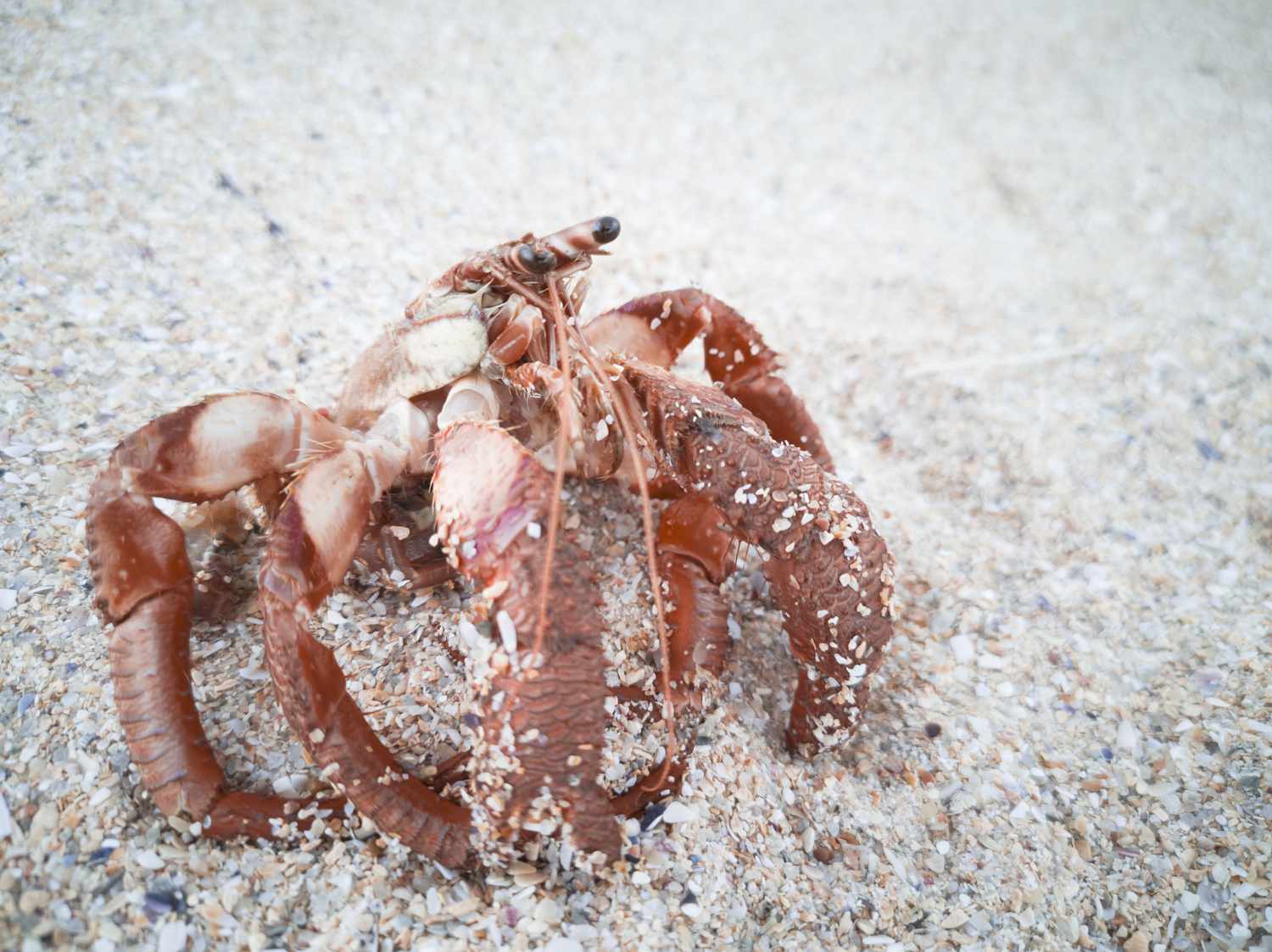Hermit crabs, those captivating crustaceans that tote their homes on their backs, never cease to intrigue us. Their quirky personalities make them beloved pets, but how long can we expect these little companions to grace us with their presence? The answer, much like the crabs themselves, is more complex than it seems.
Debunking the Lifespan Myths: Wild vs. Captivity
In the vast expanse of the ocean, hermit crabs can truly flourish, with some hardy species living for an impressive 30 years or more. However, life in captivity often paints a different picture. Sadly, without proper care, these fascinating creatures may only live for a few years.
This discrepancy arises from the crucial need to replicate their natural environment as closely as possible. Imagine a boundless beach, teeming with opportunities for exploration and sustenance – that’s the ideal scenario we aim to recreate.
Unpacking the Factors Impacting Lifespan
A content hermit crab is likely to be a long-lived hermit crab. Just like us, their well-being, and ultimately their lifespan, hinges on several key factors:
Habitat: More Than Just a Home
- Space to Thrive: Crabs require ample space to explore, molt, and engage in natural behaviors. Cramped conditions can lead to stress and compromise their health.
- Burrowing Bliss: In their natural habitat, hermit crabs dig and burrow in the sand. Providing a deep layer of substrate, a mixture of sand and coconut fiber, allows them to satisfy this innate need, which is essential for molting and stress reduction.
- Climate Control: Maintaining the right temperature and humidity levels is crucial. Think tropical—warm and humid—which mirrors their native environment and supports their respiratory systems.
**Dietary Delights for a Long Life **
- A Diverse Palate: Hermit crabs thrive on variety. A balanced diet of fresh fruits, veggies, and protein sources is essential for their overall health and longevity.
- Hydration is Key: Access to both freshwater and saltwater is non-negotiable. Freshwater is for drinking, while saltwater helps them maintain the delicate balance of water within their shells.
Stress: A Silent Killer
- Avoiding the Crowd: Overcrowding can lead to competition for resources and unnecessary stress, ultimately impacting their lifespan.
- Silence is Golden: Loud noises can be incredibly stressful for these sensitive creatures, negatively affecting their overall health and longevity.
Lifespan Across Different Hermit Crab Species
Just as different dog breeds have varying lifespans, different hermit crab species have different average lifespans. Let’s compare:
| Hermit Crab Species | Average Lifespan in Captivity | Potential Lifespan in the Wild |
|---|---|---|
| Ecuadorian Hermit Crab | 10-15 years | Over 30 years |
| Strawberry Hermit Crab | 1-4 years | 25-30 years |
| Ruggie Hermit Crab | 4-7 years | Over 15 years in ideal environments |
It’s important to remember that these are just averages. Providing excellent care can significantly increase your hermit crab’s chances of enjoying a longer, healthier life, even in captivity.
Curious about the typical lifespan of a hermit crab? Find out all about it when you click here: hermit crab average lifespan.
Busting the 10-Year Myth
A common misconception is that hermit crabs are short-lived pets, only surviving for a decade at most. This simply isn’t true! While their lifespan in captivity is often shorter due to various factors, providing proper care can help them live for decades, just like their wild counterparts. It’s all about understanding their needs and creating an enriching environment that promotes longevity.
Our Responsibility as Hermit Crab Keepers
The lifespan of a hermit crab, particularly in captivity, should encourage us to reflect on the responsibility we assume when we choose to keep them as pets. By striving to replicate their natural environment—providing them with spacious homes, a nutritious diet, and a stress-free life—we can ensure these fascinating creatures thrive under our care. Their well-being, and ultimately how long they live, depends on the choices we make.
Simple Steps for a Longer, Happier Hermit Crab Life
Ready to give your hermit crab the best possible life? It’s simpler than you might think. Here are a few actionable tips:
- Spacious Digs: Invest in a large terrarium or aquarium—bigger is always better when it comes to providing ample space.
- Digging for Joy: Provide a deep layer of substrate, a mixture of sand and coconut fiber works well, for burrowing and molting.
- Tropical Paradise: Maintain a warm, humid environment using heat lamps and regular misting.
- Food for Thought: Offer a varied diet of fresh fruits, vegetables, and protein sources. Don’t be afraid to experiment and see what your crabs enjoy!
- Freshwater and Saltwater Oasis: Provide separate dishes for freshwater and saltwater, ensuring they are always clean and accessible.
- Peace and Quiet: Keep their enclosure in a quiet area of your home, away from loud noises and vibrations.
Remember, a hermit crab’s lifespan is more than just a number—it’s a reflection of the care we provide. By understanding their needs and making a conscious effort to mimic their natural environment, we can help these captivating creatures live long, fulfilling lives under our care.
How Long Do Hermit Crabs Live as Pets? Species-Specific Insights
So, you’re curious about how long these fascinating crustaceans can live under your care? It’s remarkable to note that hermit crabs possess the potential to enjoy surprisingly long lifespans, even outside their natural habitat. In fact, their lifespans in captivity can sometimes rival those of their wild counterparts! This largely depends on whether they receive the appropriate care and a stimulating environment. That’s why understanding the specific needs of different hermit crab species is crucial – it’s the key to ensuring they live long, healthy lives.
You might have heard tales of hermit crabs in the wild living for decades – and those stories aren’t mere folklore. Consider the Ecuadorian hermit crab (Coenobita compressus), for instance. These resilient creatures can sometimes live for over 30 years in their natural habitat. Unfortunately, when kept as pets, they often don’t reach such impressive ages, frequently due to well-intentioned but misguided care.
It’s essential to acknowledge that different species don’t share the same lifespan, whether in a tank or in their natural environment. Let’s explore some of the most common hermit crab species kept as pets:
- Strawberry Hermit Crab (Coenobita perlatus): These vibrantly colored crabs can live up to 30 years in the wild. However, in captivity, they typically live for 1 to 4 years. The good news is that, with proper care, they can live significantly longer!
- Ecuadorian Hermit Crab (Coenobita compressus): As previously mentioned, these crabs are renowned for their remarkable lifespans in the wild, with some documented cases exceeding 30 years. On average, they tend to live around 10-15 years under ideal conditions. Astonishingly, with optimal care in captivity, these tiny creatures have the potential to live for several decades.
- Ruggie Hermit Crab (Coenobita rugosus): These crabs typically live for 4 to 7 years in captivity. However, there are reports of Ruggies living well past 15 years, which is truly exceptional!
So, what’s the secret to helping your hermit crab live a long, fulfilling life? It all boils down to a few fundamental factors: habitat, diet, and socialization.
First and foremost, let’s discuss their habitat. You might assume any tank will suffice, but it’s crucial to ensure it’s the right size – spacious enough to accommodate their climbing and hiding needs. Remember, these little creatures love to burrow, so provide a generous layer of substrate, a blend of sand and coconut fiber, for their burrowing pleasure. Temperature and humidity are equally vital. Each species has its preferences, so thorough research is essential to replicate their natural environment as closely as possible.
Next, let’s delve into their diet. A varied diet is paramount for maintaining your hermit crab’s health and happiness. Think fresh fruits, veggies, protein sources, and a sprinkle of calcium supplement for good measure. It’s important to note that commercially available hermit crab food often lacks the essential nutrients your crabby companion needs to thrive.
Lastly, let’s not forget about socialization. Hermit crabs are, contrary to their name, social creatures that flourish in the company of their kind. If you’re only caring for one, consider adding at least one more to their habitat.
Key Takeaways:
- By providing proper care, you can help your hermit crab live for many happy years in your home.
- Remember that different species have different needs and lifespans, so research is your best friend!
- A comfortable and stimulating habitat, a varied and nutritious diet, and ample opportunities for socialization are the cornerstones of a long, healthy life for your crustacean companion.
There you have it! By following these tips and investing a little effort, you can create a loving environment where your hermit crab can thrive.
Do Hermit Crabs Recognize Their Owners? Exploring the Possibilities
You’ve welcomed a tiny, shell-dwelling roommate into your life – it’s an experience like no other. As you observe their unique behaviors, you might start to wonder if your little hermit crab recognizes you. It’s easy to feel a connection when they scuttle towards you or seem more at ease in your presence. But can they truly recognize their owners in the same way a dog might?
Here’s the reality: a hermit crab’s brain isn’t wired for complex emotions like that. They don’t form bonds in the way humans do. Their instincts primarily revolve around survival – seeking safety, finding food, and avoiding threats.
However, don’t despair! While they might not recall your face or name, they excel at recognizing routines and associating them with positive or negative experiences. If you consistently handle them gently and maintain a calm environment, they’ll probably learn to link your presence with safety and positive interactions. This can lead to them feeling more comfortable emerging from their shells, accepting food from you, or even hanging out near you.
It’s important to note that this learned association isn’t equivalent to “recognition” in the human sense. It’s more about them understanding that you represent a source of comfort and nourishment, not a threat to their well-being.
In their natural environment, these resilient creatures can live for decades. Sadly, their lifespans in captivity are often significantly shorter if their needs aren’t met. That’s why it’s essential to go beyond providing basic survival needs and strive to replicate their natural habitat as closely as possible.
Imagine spacious enclosures with cozy hiding spots, opportunities for climbing, and a deep layer of substrate for digging – that’s the dream setup for a happy hermit crab. And remember, hermit crabs are social butterflies (or should we say, social crustaceans?). Keeping them in groups is crucial for their overall well-being.
So, while your hermit crab might not be penning heartfelt letters anytime soon, providing them with a secure, stimulating environment will undoubtedly contribute to a happier crab. Who knows, maybe those scuttles and shell waves are their way of expressing gratitude for your dedication to their care.
What Is the Oldest Living Hermit Crab? Uncovering a Record-Breaking Crustacean
We’ve explored how long hermit crabs can live, but what about the oldest ones documented? As it turns out, these little critters are full of surprises! In the vast expanse of the ocean, where resources are abundant and hiding spots are plentiful, hermit crabs can live for astonishingly long periods – we’re talking decades! Some species, like the Ecuadorian hermit crab, might even reach the grand old age of 30 or more. This longevity is due in part to the ocean’s bounty of food and their impressive camouflage skills, which help them evade becoming someone else’s lunch.
However, when we introduce hermit crabs into our homes, the dynamics change. While we strive to provide them with wonderful lives, the average hermit crab in captivity might live somewhere between 3 to 10 years. While this is still a significant amount of time, it pales in comparison to their wild counterparts. Why the disparity?
Imagine living your entire life in a spacious house with an endless supply of your favorite snacks, then suddenly finding yourself in a smaller apartment with limited food options. It’s not quite the same, is it? Similarly, hermit crabs in captivity might not receive the same variety of nutrients from commercially available food as they would in their natural habitat. Furthermore, let’s be honest, we sometimes unintentionally stress them out with handling or changes to their tanks. All these factors can, unfortunately, impact their lifespan.
But there’s a beacon of hope! Enter Jonathan Livingstone, an extraordinary hermit crab who defied the odds and lived to the ripe old age of 44! Jonathan spent his days in Florida, enjoying a leisurely retirement at the Shell Point Retirement Community (how fitting!). His incredible story demonstrates that with abundant love, meticulous care, and a super comfy environment, hermit crabs can live far longer than we might expect, even in captivity. Jonathan’s legacy serves as a poignant reminder that these tiny creatures are full of surprises and deserving of all the love and care we can shower upon them.
Do you want to know the price of a hyacinth macaw? Click here to find out: hyacinth macaw price.
- Unlock 6000+ words beginning with he: A comprehensive analysis - April 20, 2025
- Mastering -al Words: A Complete Guide - April 20, 2025
- Master Scrabble: High-Scoring BAR Words Now - April 20, 2025

















2 thoughts on “Hermit Crab Life Expectancy: Wild vs. Captivity Uncovering the Truth About Their Lifespan”
Comments are closed.